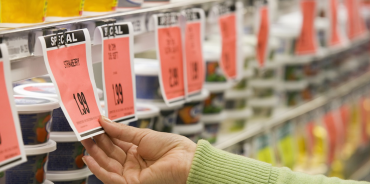Grocery in the Age of Inflation: Learnings and Recommendations – Part II
This is the second in a two-part series exploring dunnhumby’s learnings and recommendations during this continuing period of unprecedented inflation. You’ll find the first piece – which looks at inflation’s likely impact on the grocery industry during 2023
Over the past 12 months, we’ve been working shoulder-to-shoulder with a number of our retail clients to help them understand and respond to the issues presented by the “age of inflation”.
We’ve seen all kinds of challenges during that time: a category team that didn’t want to follow new and centralised price rules due to fears that it would compromise their profitability; a promo team that needed to cut the number of scheduled offers but had no idea where to start; a price team struggling to know which items to lock down in order to generate the best return on investment. It’s an undeniably complex market right now.
With that in mind, and based on the excellent work done by our retail teams around the world, I wanted to share five key actions that could help you tackle issues like those above – and better prepare your business for the year ahead.
1. Refresh your customer understanding
Are you tracking the right KPIs? Knowing what to look at when considering inflation’s impact on your business is just as important as measuring your performance in the first place. Over the past year, we’ve worked closely with a number of retailers to track inflation at customer level, allowing them to see the resultant shift in behaviours.
Beginning by using data science to define typical baskets across customer segments, we then developed a solution to track the adoption of different value seeking strategies – allowing us to see how changes in the cost of living drove those tactics and with which customers. This has given our clients an inflation-centric view of product switching, volume reduction, customer lapsing, and year-on-year sales.
2. Be strategic about your pricing
Do you know what your Key Value Items (KVIs) are? A list of products that considers your customers’ needs – by segment and by those most sensitive to price – can help you stand out from the competition in two ways.
Firstly, from a top line perspective, a KVI list can help prevent customers from switching to discounters by showing them that you’re investing in the products they care most about. Secondly, from a bottom line perspective, a well-informed KVI list gives you the ability to focus your pricing investments around those products and categories that will deliver the best returns.
3. Focus on getting more private label goods into baskets
A strong private label strategy can go a long way to reinforcing your value perception. Key to that is the ability to spot any gaps in your offer and tailor your range around customer needs – both now and as they change.
There are two major obstacles to this. Firstly, turning a private label into a genuine private brand requires a great deal of effort in terms of branding, communications, and product investment. Secondly, it’s not uncommon for private labels to be spread across categories and needs, with little in the way of a clear, consistent, and well-defined scope.
Nonetheless, the importance of private brand is such that even those retailers that have paid little attention to it over the past few years are now working hard to catch up. As explained in this report, customer data science can provide the structure needed to shape those key decisions and deliver a high-performing private brand strategy.
4. Reduce assortment in key categories
Data science proves that as much as 20% of the average retailer’s assortment can be delisted without negative consequences either for Customers or to commercial results. In fact, a slimmed-down assortment can actually improve sales and profits, so understanding which categories are most important for customers (particularly price sensitive and loyal ones) is a valuable exercise.
The priority here is to simplify shopper choices and create positive price perceptions while still addressing unique need states. Typically, this means consolidating your buying power around those products and brands that matter most to customers and allocating more shelf space to those goods. At the other end of the scale, reducing the cost to serve on less profitable products and categories is equally vital.
5. Deliver smarter campaigns
In times like these, promotions can play a key role in attracting value-seeking customers to your banner. Without the right controls in place, however, they can also lead to unfavourable like-for-like comparisons and see retailers at the whim of supplier-driven incentive programmes. Money and time can very easily be wasted chasing down unmatchable (and often irrelevant) offers.
For this reason alone, many retailers are now using data science to reduce the number of active promotions and move towards tailored and relevant campaigns. This tends to require a combined focus on digital assets (i.e. apps and websites) and physical media (i.e. coupons at the till) in order to deliver personalised promotions that cater to factors like lifestyle, life stage, and price sensitivity.
While work is required, though, the returns from such an approach can be more than worthwhile. Not only does a contextual approach to promotions help to optimise investment, it also ensures that customers find real value in their baskets, customised offers giving them a reason to stay loyal (and even increase their spend across categories).
Inflation Discovery & Plan
dunnhumby Inflation Discovery & Plan enables retailers to identify the priority actions they can take and the key areas to absorb inflation to deliver to the changing needs of their customers, while creating savings to protect their margin.
Get in touchTOPICS
RELATED PRODUCTS
A look at dunnhumby’s unique Customer Data Science, which is at the core of everything we do.
Data Science solutionsThe latest insights from our experts around the world
AI-powered, personalised loyalty: the next frontier in the pursuit of customer relevance
Six ways in which New Zealand’s suppliers can strike the balance between pricing and promotion




